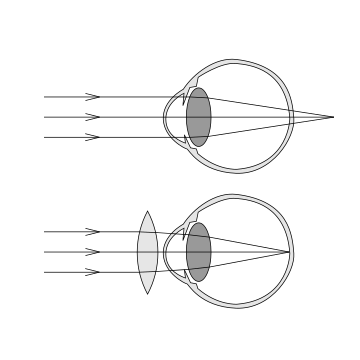¿Lo sabías?
Puedes hacer doble clic en una palabra para buscarla en TermGallery.
Puedes hacer doble clic en una palabra para buscarla en TermGallery.
Significados de hyperopia en inglés

Abnormal condition in which vision for distant objects is better than for near objects.
Sinónimos
Examples for "farsightedness"
Examples for "farsightedness"
1
It is, however, due to the farsightedness and enterprise of Mr. C.H.
2
Wilhelm II with his keen farsightedness set about to remedy this.
3
Mrs. Budlong's campaign was undertaken with the same farsightedness as a magazine editor's.
4
It is often advertised that it can cure everything from farsightedness to hair loss.
5
Soon afterwards, eyeglasses were available to correct farsightedness.
1
This will is a living monument to his good sense and far-sightedness.
2
In fact, however, this was the crowning manifestation of his wariness and far-sightedness.
3
The habit of saving calls for self-control, far-sightedness and imagination.
4
And it isn't a freak of nature, Bruce-it'ssimply a result of Nature's far-sightedness.
5
Was it a kind of far-sightedness and near blindness?
1
They also examined other animals, and the same proportion of hypermetropia existed.
2
Ocular examination showed hypermetropia 1.5 D. R. and L. with marked astigmatism.
3
Surveillance: Routine ophthalmologic examinations for hypermetropia and strabismus; monitoring for progressive spine deformities; routine monitoring for other medication complications depending on the organ system involved.
1
Most cases of squinting are caused by longsightedness, the muscles being strained in the effort to obtain distinct vision.
Uso de hyperopia en inglés
1
These results confirm the previously reported association between myopia, hyperopia, and nuclear opacity.
2
Refraction in preterms during childhood progresses from hyperopia to myopia.
3
The severity of lens nuclear opacity was positively associated with myopia and negatively associated with hyperopia.
4
Grand Seiko gives relatively better performance in detecting myopia, hyperopia, and high myopia for school age children.
5
All eyes experiencing hyperopia initially grew more than their fellow eyes and exhibited myopic shifts in refraction.
6
A subanalysis of subjects without cataract showed increasing hyperopia with age and an association between myopia and higher education.
7
Prevalence was reversed in hyperopia, with a higher prevalence in subjects aged 50 to 69.
8
Although eyes responded differentially to plus and minus lenses, the plus lenses generally corrected the hyperopia present in these young animals.
9
Finally, our study confirms the influence of corneal thickness on IOP measures, and the prevalence of hyperopia among children with growth defect.
10
Based on photographic evidence and a 1932 prescription for glasses, a Spanish ophthalmologist suggests the writer suffered from hyperopia and not myopia.
11
Lens powers were selected to slightly undercorrect or overcorrect the induced hyperopia in LX eyes and to induce comparable hyperopia in sham-surgery eyes.
12
Myopia was defined as spherical equivalent refractive error of at least -0.50 D and hyperopia as +2.00 D or more.
13
Myopia -0.5 diopter or less in either eye or hyperopia 2 diopters or greater was observed in less than 3% of children.
14
Hyperopia risk was associated with female gender and myopia risk with older age.
15
Hyperopia was associated with female gender.
16
Hyperopia in at least one eye was present in 0.8% of children, with no significant predictors.
Sobre este término
Colocaciones frecuentes
Más colocaciones
Translations for hyperopia
portugués
catalán
español
Hyperopia a través del tiempo

